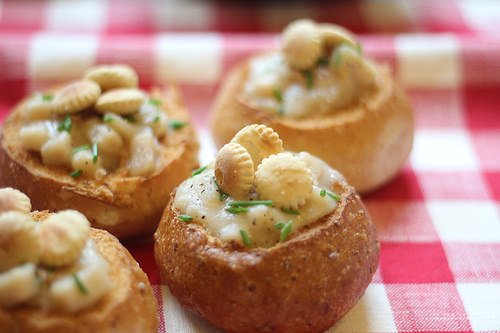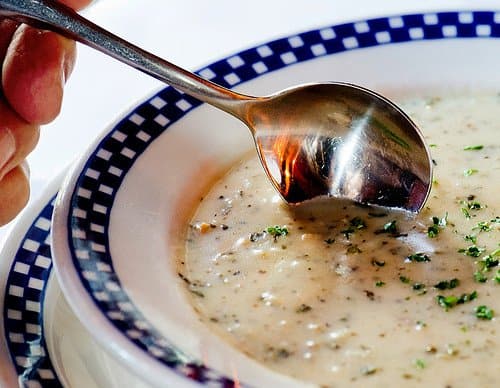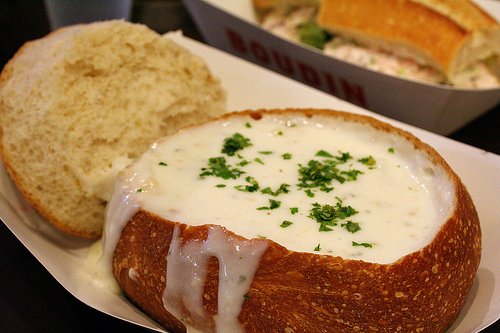Nothing soothes the soul quite like a bowl of piping hot clam chowder! Clam chowder is virtually a complete meal itself although it can be enjoyed as a snack. Can you freeze clam chowder? Although shellfish like clams, which are some of the main ingredients of a clam chowder, is tricky to freeze, it’s possible to store your leftovers in the freezer.
Chowder is a term used for any type of vegetable soups served with a creamy, thick base. Usually, the base is thickened with milk, heavy cream, cheese, flour, or crushed pilot biscuits. Traditionally, clam chowder is made with heavy cream, which is quite sensitive to freezing temperature. In addition, seafood shouldn’t be stored too long in the freezer.
There are several things to consider before freezing any type of cream-based soups. However, as long as the soup has been prepared properly, there is no reason why you shouldn’t whip up a make-ahead batch of clam chowder!
Types of Clam Chowder
Did you know that there are different versions of clam chowder? The ingredients of the clam chowder could affect the soup’s texture and flavor after freezing.

New England Clam Chowder
This is the ubiquitous version of clam chowder. It’s traditionally made with chopped clams, potatoes, and onions. New England clam chowder has a heavy cream base and butter, which are delicate ingredients. This classic chowder is often served in a sourdough bread bowl
Manhattan Clam Chowder
This is a type of clam stew that originated in New York. Manhattan clam chowder has a thin vegetable broth because the soup doesn’t contain potatoes. The broth is a distinct red shade because of the tomato juice base. Since Manhattan clam chowder does not contain heavy cream and potatoes, it is quite freezer-friendly.
Rhode Island Clam Chowder
This soup originated in the southern coast of Rhode Island. Just like Manhattan clam chowder, Rhode Island clam chowder has a broth base. However, the base is somewhat thicker than Manhattan clam chowder because it contains potatoes. This dish is often made with hard clams called quahogs.
Factors to Consider Before Freezing Clam Chowder
Exclude Delicate Ingredients
As mentioned earlier in this post, clam chowder contains several ingredients that don’t freeze well. These ingredients include the heavy cream, the clams, and the vegetables. In addition, some chowder ingredients will go bad faster than the rest of the ingredients.
If you are making homemade clam chowder, we highly suggest excluding the vegetables (celery and potatoes) during freezing until you are ready to serve. You may exclude the heavy cream although the chowder’s umami taste will not be as pronounced once the heavy cream is added during reheating. Do not be afraid to experiment to prolong the shelf life of the clam chowder. Since you are making the chowder from scratch, you can add or exclude certain ingredients as you see fit.
Preventing Bitterness
Did you know that certain herbs and spices become bitter once stored in the freezer? Flavor changes are inevitable when you are freezing delicate ingredients so be sure to skip the herbs and spices if needed.

Preventing Rancidity in Dairy Products
Clam chowder gets its distinct richness and umami flavor from several dairy products. Unfortunately, fats from dairy ingredients could become rancid, which will affect the flavor of the chowder once thawed and reheated. In addition, heavy cream has the tendency to curdle when frozen and thawed. You can either skip the cream until serving the frozen chowder or add more of it to restore the soup’s original texture.
Half-Cooked Vegetables
If you know that you’ll have plenty of leftover clam chowder, do not cook the vegetables all the way through. This goes especially for the celery and the potatoes, they could turn mushy and unpalatable once the frozen clam chowder has been thawed and reheated. If you can, try scooping out all the potatoes from the leftover soup prior to freezing. Then, freeze the chowder and the potatoes in different containers so the texture won’t turn grainy once reheated.
Quick Cooling the Clam Chowder
Quick cooling the clam chowder minimizes the risk of bacterial growth. Since the soup is not left sitting at room temperature for long, pathogens have little time to multiply. To cool the soup quickly, immerse the pot of clam chowder in tap water, making sure the water doesn’t reach the brim of the pot. With a ladle, stir the soup continuously until it cools down.
Shelf Life, Thawing and Reheating Suggestions
When kept in the freezer, clam chowder could last for 4 to 6 months. Always keep the temperature at a steady 0 degrees Fahrenheit so the clams are preserved well. We recommend consuming your supply right away for optimal flavor. Never refreeze thawed clam chowder, its taste and flavor will be altered completely.

Thawing the clam chowder has to be quick so it’s best to submerge the container in a basin of hot water. Leave the chowder to thaw into chunks for about 10 to 15 minutes. Pour the thawed chowder into a saucepan then simmer over medium-high heat. Stir the chowder briskly as it melts into a liquid. Brisk stirring will prevent curdling!
At this point, you can add the other ingredients you may have excluded prior to freezing. You can also add more milk or broth to loosen the consistency of the clam chowder. Bring the clam chowder to a boil for a minute then leave to cool down to warm before serving. Do not use the microwave to reheat the frozen clam chowder.
Summary
Can you freeze clam chowder? It’s not the ideal option for preserving leftover clam chowder but freezing works in a pinch! You don’t want to waste a good batch of clam chowder, right? Just keep all these tips in mind so you can prep the chowder well prior to freezing and get great results.